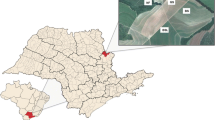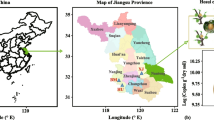Abstract
The assessment of bacterial communities in soil gives insight into microbial behavior under prevailing environmental conditions. In this context, we assessed the composition of soil bacterial communities in a Brazilian sugarcane experimental field. The experimental design encompassed plots containing common sugarcane (variety SP80-1842) and its transgenic form (IMI-1 — imazapyr herbicide resistant). Plants were grown in such field plots in a completely randomized design with three treatments, which addressed the factors transgene and imazapyr herbicide application. Soil samples were taken at three developmental stages during plant growth and analyzed using 16S ribosomal RNA (rRNA)-based PCR-denaturing gradient gel electrophoresis (PCR-DGGE) and clone libraries. PCR-DGGE fingerprints obtained for the total bacterial community and specific bacterial groups — Actinobacteria, Alphaproteobacteria and Betaproteobacteria — revealed that the structure of these assemblages did not differ over time and among treatments. Nevertheless, slight differences among 16S rRNA gene clone libraries constructed from each treatment could be observed at particular cut-off levels. Altogether, the libraries encompassed a total of eleven bacterial phyla and the candidate divisions TM7 and OP10. Clone sequences affiliated with the Proteobacteria, Actinobacteria, Firmicutes and Acidobacteria were, in this order, most abundant. Accurate phylogenetic analyses were performed for the phyla Acidobacteria and Verrucomicrobia, revealing the structures of these groups, which are still poorly understood as to their importance for soil functioning and sustainability under agricultural practices.




Similar content being viewed by others
References
Altschul SF, Madden TL, Schaäffer AA, Zhang JH, Zhang Z, Miller W, Lipman DJ (1997) Gapped BLAST and PSI-BLAST: a new generation of protein database search programs. Nucleic Acid Res 25:3389–3402
Andreote FD, Azevedo JL, Araújo WL (2009) Assessing the diversity of bacterial communities associated with plants. Braz J Microbiol 40:417–432
Andreote FD, Mendes R, Dini-Andreote F, Rossetto PB, Labate CA, Pizzirani-Kleiner AA, van Elsas JD, Azevedo JL, Araújo WL (2008) Transgenic tobacco revealing altered bacterial diversity in the rhizosphere during early plant development. Antonie Leeuwenhoek 93:415–424
Baldani JI, Caruso L, Baldani VLD, Goi SR, Döbereiner J (1997) Recent advances in BNF with non-legume plants. Soil Biol Biochem 29:911–922
Baldani JI, Reis VM, Baldani VLD, Döbereiner J (2002) A brief story of nitrogen fixation in sugarcane — reasons for success in Brazil. Funct Plant Biol 29:417–423
Boddey RM, Urquiaga S, Alves BJR, Reis V (2003) Endophytic nitrogen fixation in sugarcane: present knowledge and future applications. Plant Soil 252:139–149
Brons JK, van Elsas JD (2008) Analysis of bacterial communities in soil by use of denaturing gradient gel electrophoresis and clone libraries, as influenced by different reverse primers. Appl Environ Microbiol 74:2717–2727
Goldemberg J (2007) Ethanol for a sustainable energy future. Science 315:808–810
Gomes NCM, Heuer H, Schonfeld J, Costa R, Mendonca-Hagler L, Smalla K (2001) Bacterial diversity of the rhizosphere of maize (Zea mays) grown in tropical soil studied by temperature gradient gel electrophoresis. Plant Soil 232:167–180
Heuer H, Krsek M, Baker P, Smalla K, Wellington EMH (1997) Analysis of Actinomycete communities by specific amplification of genes encoding 16S rRNA and gel-electrophoretic separation in denaturing gradients. Appl Environ Microbiol 63:3233–3241
James EK (2000) Nitrogen fixation in endophytic and associative symbiosis. Field Crops Res 65:197–209
Janssen PH (2006) Identifying the dominant soil bacterial taxa in libraries of 16S rRNA and 16S rRNA genes. Appl Environ Microbiol 72:1719–1728
Janssen PH, Yates PS, Grinton BE, Taylor PM, Sait M (2002) Improved culturability of soil bacteria and isolation in pure culture of novel members of the divisions Acidobacteria, Actinobacteria, Proteobacteria, and Verrucomicrobia. Appl Environ Microbiol 68:2391–2396
Kimura M (1980) A simple method for estimating evolutionary rates of base substitutions through comparative studies of nucleotide-sequences. J Mol Evol 16:111–120
Kowalchuk GA, Bruinsma M, van Veen JA (2003) Assessing responses of soil microorganisms to GM plants. Trends Ecol Evol 18:403–410
Lane DJ, Pace B, Olsen GJ, Stahl DA, Sogin ML, Pace NR (1985) Rapid-Determination of 16S ribosomal-RNA sequences for phylogenetic analyses. Proc Natl Acad Sci USA 82:6955–6959
Letunic I, Bork P (2007) Interactive Tree Of Life (iTOL): an online tool for phylogenetic tree display and annotation. Bioinformatics 23:127–128
Liu B, Zeng Q, Yan F, Xu H, Xu C (2005) Effects of transgenic plants on soil microorganisms. Plant Soil 271:1–13
Loiret FG, Grimm B, Hajirezaei MR, Kleiner D, Ortega E (2009) Inoculation of sugarcane with Pantoea sp. increases amino acid contents in shoot tissues; serine, alanine, glutamine and asparagine permit concomitantly ammonium excretion and nitrogenase activity of the bacterium. J Plant Physiol 166:1152–1161
Ludwig W, Strunk O, Westram R et al (2004) ARB: a software environment for sequence data. Nucleic Acids Res 32:1363–1371
Luvizotto DM, Marcon J, Andreote FD, Dini-Andreote F, Neves AAC, Araújo WL, Pizzirani-kleiner AA (2010) Genetic diversity and plant-growth related features of Burkholderia spp. from sugarcane roots. World J Microbiol Biotechnol (in press)
McCourt JA, Pang SS, King-Scott J, Guddat LW, Duggleby RG (2005) Herbicide-binding sites revealed in the structure of plant acetohydroxyacid synthase. Proc Natl Acad Sci USA 103:569–573
Mendes R, Pizzirani-Kleiner AA, Araujo WL, Raaijmakers JM (2007) Diversity of cultivated endophytic bacteria from sugarcane: genetic and biochemical characterization of Burkholderia cepacia complex isolates. Appl Environ Microbiol 73:7259–7267
Mirza MS, Ahmad W, Latif F, Haurat J, Bally R, Normand P, Malik KA (2001) Isolation, partial characterization, and the effect of plant growth-promoting bacteria (PGPB) on micro-propagated sugarcane in vitro. Plant Soil 237:47–54
Muthukumarasamy R, Revathi G, Vadivelu M (2000) Antagonistic potential of N2-fixing Acetobacter diazotrophicus against Colletotricum falcatum Went., a causal organism of red-rot of sugarcane. Curr Sci 78:1063–1065
Nunes da Rocha U, Andreote FD, Azevedo JL, van Elsas JD, van Overbeek LS (2010) Cultivation of hitherto-uncultured bacteria belonging to the Verrucomicrobia subdivision 1 from the potato (Solanum tuberosum L.) rhizosphere. J Soils Sediments 10:326–339
Oliveira ALM, Stoffels M, Schmid M, Reis VM, Baldani JI, Hartmann A (2009) Colonization of sugarcane plantlets by mixed inoculations with diazotrophic bacteria. Eur J Soil Biol 45:106–113
Rademaker J, Louws FJ, Versalovic J, Bruijn FJ (2004) Computer-assisted analysis of molecular fingerprint profiles and database construction. In: Kowalchuk GA, Bruijn FJ, Head IM, Akkermans AD, van Elsas JD (eds) Molecular microbial ecology manual. Kluwer Academic Publishers, Dordrecht, pp 1397–1446
Saitou N, Nei M (1987) The neighbor-joining method: a new method for reconstructing phylogenetic trees. Mol Biol Evol 4:406–425
Schloss PD, Handelsman J (2005) Introducing DOTUR, a computer program for defining operational taxonomic units and estimating species richness. Appl Environ Microbiol 71:1501–1506
Schmalenberger A, Tebbe CC (2003) Bacterial diversity in maize rhizospheres: conclusions on the use of genetic profiles based on PCR-amplified partial small subunit rRNA genes in ecological studies. Mol Ecol 12:251–261
Singleton DR, Furlong MA, Rathbun SL, Whitman WB (2001) Quantitative comparisons of 16S rRNA gene sequence libraries from environmental samples. Appl Environ Microbiol 67:4374–4376
Smalla K, Oros-Sichler M, Milling A, Heuer H, Baumgarte S, Becker R, Neuber G, Kropf S, Ulrich A, Tebbe C (2007) Bacterial diversity of soils assessed by DGGE, T-RFLP and SSCP fingerprints of PCR-amplified 16S rRNA gene fragments: do the different methods provide similar results? J Microbiol Methods 69:470–479
Stuart RM, Romão AS, Pizzirani-kleiner AA, Azevedo JL, Araújo WL (2010) Culturable endophytic filamentous fungi from leaves of transgenic imidazolinone-tolerant sugarcane and its non-transgenic isolines. Arch Microbiol 192:307–313
Tiedje JM, Asuming-Brempong S, Nüsslein K, Marsh TL, Flynn SJ (1999) Opening the black box of soil microbial diversity. Appl Soil Ecol 13:109–122
Torsvik V, Ovreas L (2002) Microbial diversity and function in soil: from genes to ecosystems. Curr Opin Microbiol 5:240–245
Weinert N, Meincke R, Gottwald C, Heuer H, Gomes NCM, Schloter M, Berg G, Smalla K (2009) Rhizosphere communities of genetically modified zeaxanthin-accumulating potato plants and their parent cultivar differ less than those of different potato cultivars. Appl Environ Microbiol 75:3859–3865
Acknowledgements
This work was supported by a grant from FAPESP (Foundation for Research Assistance of São Paulo State, Brazil). We thank FAPESP for the fellowship to W.L.A. (Proc. n° 03/10527-4). We also thank Cristiane C. P. Hardoim for valuable assistance in library construction and Dr. Eugênio César Ulian for conduction and supervision of sugarcane management conditions in field.
Author information
Authors and Affiliations
Corresponding author
Additional information
Responsible Editor: Timothy Richard Cavagnaro.
Electronic supplementary material
Below is the link to the electronic supplementary material.
Supplemental Table S1
The table shows Chao1 richness estimations, Shannon-Weaver and Simpson diversity indices for each confidence limits assigned. “Unique”, “species” (99% and 97%), “genus” (95%) and “order” (90%) confidence limits. It was considered 16S rRNA gene sequences for each sugarcane treatment in specific (CV, TC and TH) and sequences altogether (total). (PPT 95 kb)
Supplemental Figure S1
Experimental field design. See Materials and Methods for details. Red “x” represent the two cores of subsamples collected randomly in the middle of each plot. (PPT 117 kb)
Supplemental Figure S2
Cluster analysis of DGGE fingerprints using the unweighted-pair group method for (I) total bacterial community, (II) Actinobacteria, (III) Alphaproteobacteria and (IV) Betaproteobacteria. CV, TC and TH refer to different sugarcane treatments conduced in the field (see material and methods). The numbers 1, 2 and 3 refer to samples collected in three distinct periods of sugarcane cultivation (three, ten and seventeen months, respectively). (PPT 115 kb)
Supplemental Figure S3
LIBSHUFF comparison plots of evolutionary distance by homologous coverage curves (red line) compared to heterologous coverage curve (green line). The blue line indicates the value of delta C (right y axis) for the original samples at each value of evolutionary distance. Purple line indicates the 95% of delta C for the randomized samples. The ranked values (P) of the delta C from the heterologous coverage are shown. (PPT 166 kb)
Supplemental Figure S4
Rarefaction curves of operational taxonomic units (OTU) assigned at the „unique‟, “species” (99% and 97%), “genus” (95%) and “order” (90%) levels for partial bacterial 16S rRNA gene sequences retrieved from sugarcane soil. (a), (b) and (c) refer to CV, TC and TH 16S rRNA group sequence, respectively. (d) refer to altogether sequences considered in the study. The number of OTUs were determined with DOTUR for each case evaluated. (PPT 79 kb)
Rights and permissions
About this article
Cite this article
Dini-Andreote, F., Andreote, F.D., Costa, R. et al. Bacterial soil community in a Brazilian sugarcane field. Plant Soil 336, 337–349 (2010). https://doi.org/10.1007/s11104-010-0486-z
Received:
Accepted:
Published:
Issue Date:
DOI: https://doi.org/10.1007/s11104-010-0486-z




